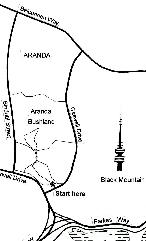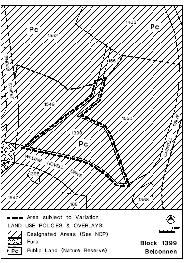

Friends of the Aranda Bushland Inc
Frost Hollow to Forest Education Kit
phone– 6251–1345, fax 6251 7621,email mefalconer@home.netspeed.com.au
Introduction
This education kit provides a range of high-quality, web-based activity sheets which encourage an exploration of some of the ecological features of the area identified in the self-guided Frost Hollow to Forest Walk. The aims of this kit include:
· fostering broad-ranging appreciation of the Aranda Bushland and the Aranda Snow Gums Heritage Site through new, creative and fun intellectual and sensory experiences;
· encouraging community learning about the social and scientific values attached to biodiversity, ecosystem functions, water quality, the impact of exotic species and current environmental remediation techniques applied in the Aranda Bushland and Aranda Snow Gums Heritage Site;
· providing activities that encourage walkers to use the publication Our Patch: Field Guide to the Flora of the Australian Capital Region as photographed in the Aranda Bushland, which Friends of the Aranda Bushland Inc published in 1997 (with financial support from three Bushcare grants from Environment Australia for the Natural Heritage Trust); and
· encouraging a longer term interest in environmental issues.

The activities in this kit are suitable for people of any age who are physically able to do the Frost Hollow to Forest Walk. The Walk starts in the frost hollow grassland from the stile off Caswell Drive on the Aranda side near Glenloch Interchange. It passes through the Aranda Snow Gums Heritage Site with its frost hollow grasslands and wildflowers, birds and kangaroos, through a Yellow Box and Red Gum woodland, then up to Aranda Bushland’s biodiversity-rich dry sclerophyll forest which includes ten eucalypt species. Interpretive signs help visitors to identify the eucalypts. These signs were developed by Friends of Aranda Bushland with support from Environment ACT and a Natural Heritage Trust grant.
The Walk takes about 2 hours to complete. It traverses stiles and has a short, fairly steep uphill section and a gently declining grade on the return journey.
For walk leaders, teachers and others with an interest, please read this introduction before using other material in this Kit, as it provides an overview of the main features of the Walk and hyperlinks to the more narrowly-focussed activity sheets.
The first 100m of the Walk
Once you cross the stile off Caswell Drive, you will walk through a lowland grassland paddock Aranda Snow Gum reserve that is striking for its lack of trees. Although this area is somewhat degraded due to infestations of exotic weeds and grasses, it has some perennial native grasses, matrushes and herbaceous plants (forbs). The paddock also has a marvelous soft khaki colour that is characteristic of the Australian bush west of the Great Dividing Range. The colour deepens as the grass seeds ripen in the late summer, as celebrated in Arthur Streeton's paintings amongst others. Link to The Art Competition Results
This is a good spot to divide into smaller groups to do activities of choice.
Some participants may choose to introduce or start the activity ‘Dining
with the Ngambri
Some members of the group that are over 12 years of age may wish to do the Tree Hollow Activity, which can be introduced here.
Others may prefer to examine freshwater biodiversity, particularly frogs , or focus on geology .
Suggested questions as you traverse this area: Can you identify the Lomandras (matrush), Poa sieberianas (snow grass), kangaroo grass (Themeda triandra) and wallaby grasses (Austrodanthonia species)? Our Patch has photos to help (see pages 61–62 and 79–83). The first interpretive sign also shows the diversity of native grasses and grassland wildflowers. Flowering peaks in early summer. A grasslands activity sheet for high school to advanced interpreters can be done here

You are passing through Aranda Snow Gum reserve, which is both a Designated Area under the National Capital Plan and Territory Land under the ACT Territory Plan. This block is part of the Hills, Ridges and Buffer area protected under the Australian Capital Territory (Planning and Land Management) Act 1988 (Cwlth). It is also Territory Land under the Land (Planning and Environment) Act 1991 (ACT), subject to a Public Land Nature Reserve Overlay. This area became part of Canberra Nature Park in 2002 following lobbing by Friends of the Aranda Bushland.
This area is naturally treeless (apart from the Eucalyptus pauciflora (Snow Gums) ahead) as it is a frost hollow which has a microclimate that is too cold for most trees and shrubs to establish naturally. On clear, still evenings, cold air drains from the hills to the lowest ground and stays there in a pool of air that is several degrees colder (as much as 6 degrees colder) than adjacent air above higher ground.
As you head towards the dam you will come to a small stand of eucalyptus which has lichen covered rocks nearby.
The dam was created in the 1960s to prevent silt flowing into Lake Burley Griffin. This area is a drainage depression that receives fluctuating levels of runoff from the adjacent slopes. Extensive soil conservation works were undertaken in this area in the 1960s to stabilise the soil and prevent further erosion. This area is being monitored and assessed to determine whether further soil stabilisation is required.
As you walk towards the Snow Gums can you see the shallow erosion gully on your left? This is a good site for upper primary students to explore the different types of soil and rocks in this area.
The Aranda Snow Gums
Largely as a result of the activities of Friends of the Aranda Bushland, the Aranda Snow Gums were listed on the ACT Interim Heritage Register in 1998, and then on the ACT Heritage Places Register when the Heritage Act 2004 (ACT) commenced in March 2005. The area is the best example in urban Canberra of a frost hollow edging the Limestone Plains that has its native vegetation largely intact. The Friends had responded to the vision of Canberra wildlife ecologist, Peter Ormay, in pursuing this listing. Tragedy occurred in the summer of 1992/3 when drift from the spraying of sweet briars caused the loss of about 70% of the foliage of the snow gums that were then on the site, including 3 very ancient snow gums. The three subsequently died. Can you see the stags that remain?
The Aranda Snow Gums is a good site to do several activities. These include:
· the impact of feral animals
· how weeding protects grassland biodiversity
· the inspiration that nature provides to poets and other writers, and artists
· getting to know our eucalypts
· how dead wood provides habitat
· identifying common birds of the Aranda Snow Gums and Aranda Bushland
The Yellow Box- Red Gum Grassy Woodland
Beyond the snow gums the walk proceeds to slip-throughs in the gates into an example of Yellow Box- Red Gum grassy woodland in the corridor through the rural lease. This is an example of an endangered ecological community that is listed as protected under the Nature Conservation Act 1980 (ACT). The grassy woodland is dominated by large blakely's Red Gums (Eucalyptus blakelyi) with Yellow Box (E. melliodora) and some Candlebark (E. rubida). The sign prompts you to recognise the species. The lessee has kindly allowed access through this area in return for the Friends of Aranda Bushland doing an annual weeding on the lease. This corridor was fenced in 2000 using Natural Heritage Trust funds.
This is an excellent site to focus on tree hollows, woodland birds and the impact of exotic animals.
Transition to Dry Sclerophyll Forest
The fence dividing Aranda Bushland from the rural lease defines the transition zone from open woodland to dry forest slopes.
The walk continues in relatively easy grades on a winding uphill track off the old road. The steps start near a large stringybark after you have checked out the sign for Broad-Leaved Peppermint (Eucalyptus dives). This is a good spot to continue eucalyptus identification activities and for musing on the mistletoe.
There's a distinct change of vegetation to dry sclerophyll forest with Red Stringybark (E. macrorhyncha) predominating. Stringybarks are easily recognised by their dark rough textured trunks. The understorey has straggly Cassinias, Poa grasses and clumps of the parasitic, cypress-like Cherry Ballart (Exocarpos cupressiformis).
Stop shortly after the path passes a large clump of Cherry Ballart. The mistletoe hanging from the Yellow Box in this area is out of control and seems to have killed the trees.
As you climb, the path turns left and there are more white trunked gums and the understorey includes the feathery leaved Silver Wattles (Acacia dealbata). The white trunked gums are Brittle Gum (E. mannifera) and Scribbly Gum (E. rossii). Distinguish them by checking for wrinkles where the trunks branch – E. rossii has the wrinkles.
The walk continues downhill on an old fence line and brings another change in vegetation. There are more flowers in the understorey and they are different from those in the uphill route. The tree trunks are mostly dark Eucalyptus macrorhyncha on the left, while those on the right are mostly white (E. rossii and E. mannifera).
www.friendsofarandabushland.org.au
Friends of Aranda Bushland, Sept 96, Nov 04, June 05 Sept 05.